Flights will definitely resume in 2020
I’ve studied all the relevant information in recent months, analyzed the existing progression models. And I can say with 99% accuracy that passenger traffic in 2020 will fully resume just before the widespread eruption of volcanoes. It seems like there is no other way how it can happen in this historical period.
Now seriously. When to expect the resumption of flights?
I am inclined to believe that before the next eruption of Eyyafyatlayokudl. Why not?
And finally, truly seriously.
In fact, I expect regular passenger flights to resume quite soon.
- Optimistic forecast – July
- Pessimistic forecast – September
- Shitty forecast – sometime later
Moreover, some regular flights to the Czech Republic, Austria, Germany and some other EU countries have already resumed in early May. In particular, I’m talking about such flights as Amsterdam – Prague (KLM), Dusseldorf – Prague (Eurowings), Minsk – Prague (Belavia), Lisbon – Vienna, Dortmund – Vienna (both – Wizz Air). And some others.
But these are only the first steps. And there is still a lot to be done to start using such a phrase as a “full resumption of passenger flights”.
Forget flights as you remember them now. At least until the summer of 2021.
A very informative video about the new flight conditions was made by the largest Asian low-cost airline – AirAsia.
What is the current situation?
Are all regular flights stopped?
No, flights are operated. The flight map on Flightradar24 confirms this. But here you can see passenger flights and cargo. We’ll separate one from another a bit lower.
What is the current intensity of flights?
If you look at the sky above Europe, you can see that there are a lot of planes.
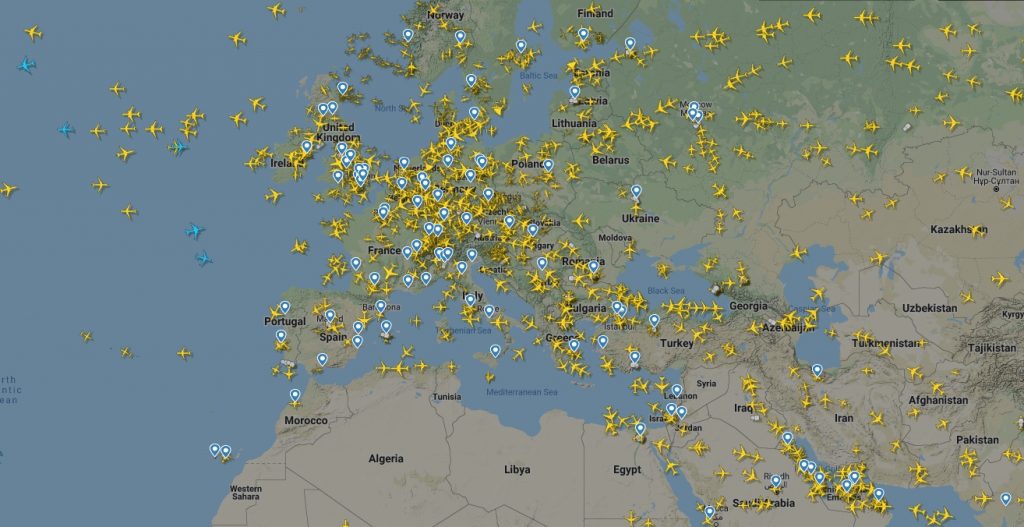
But let’s take a closer look at the sky near one of the main European airports – Frankfurt.
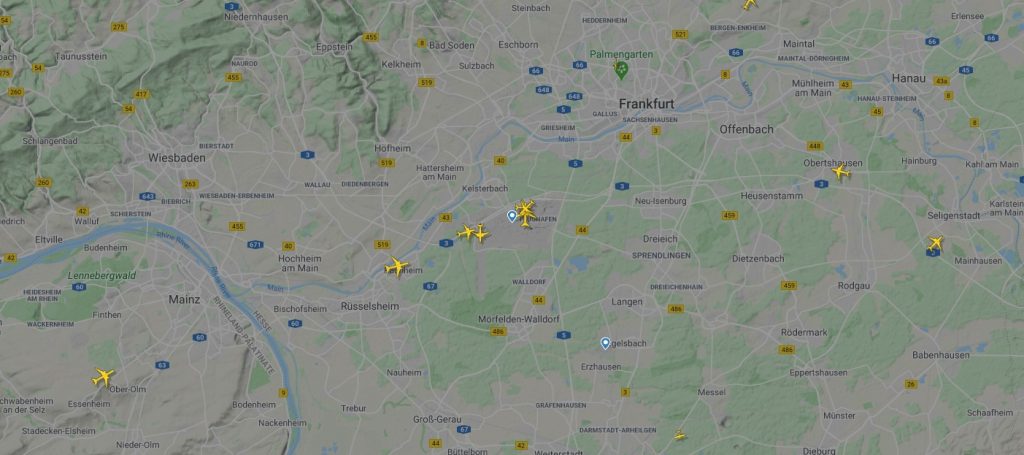
There are some airplanes. But for a Frankfurt airport, such a picture is akin to a lifeless desert.
And we are talking about the airport, which suffered almost the least in Europe. As of mid-April, Frankfurt lost 81% of its previous volume. In many other airports the number of flights was reduced by 99%.
But it’s Europe, where everything is under quarantine. Just nowhere to fly.
Let’s look at Doha. It’s the base airport for Qatar Airways. Unlike many airlines, it continues to fly across many regular destinations. For example, at the end of April, there are four flights a week to Bali. Prices, however, are not encouraging.
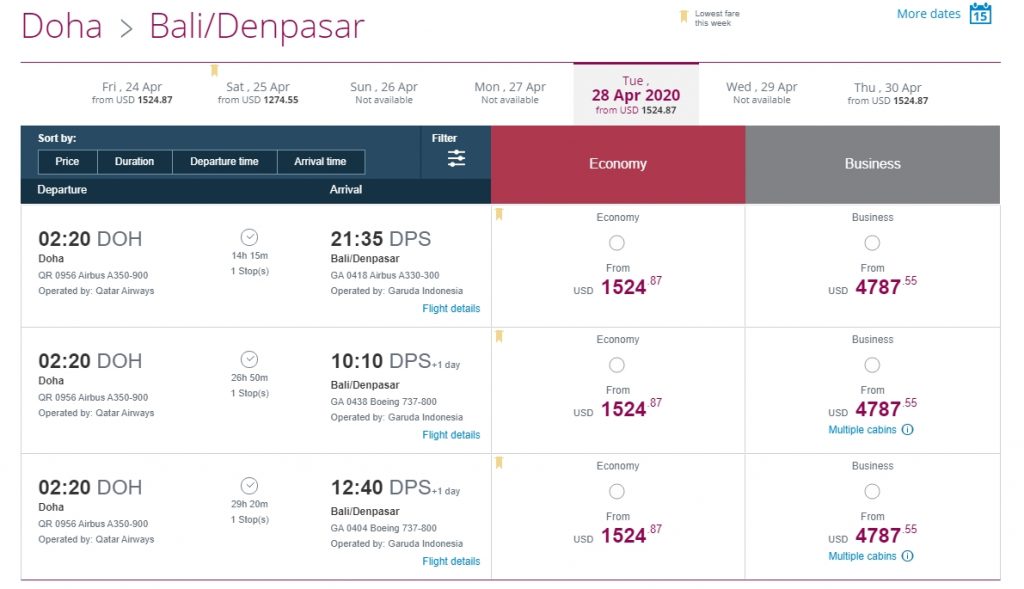
And this is how the surroundings of Doha Airport look like.
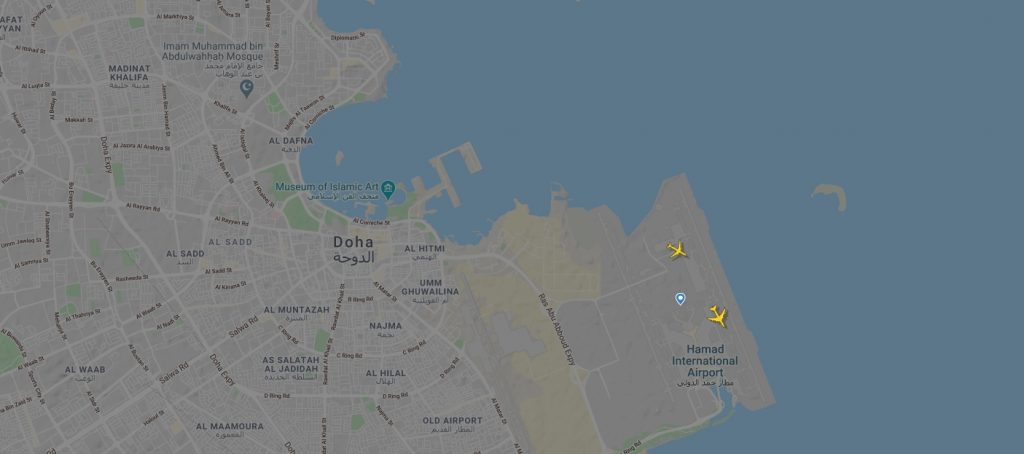
Maybe everyone sharply reoriented to Dubai airport? Here is a picture in the sky over the United Arab Emirates.
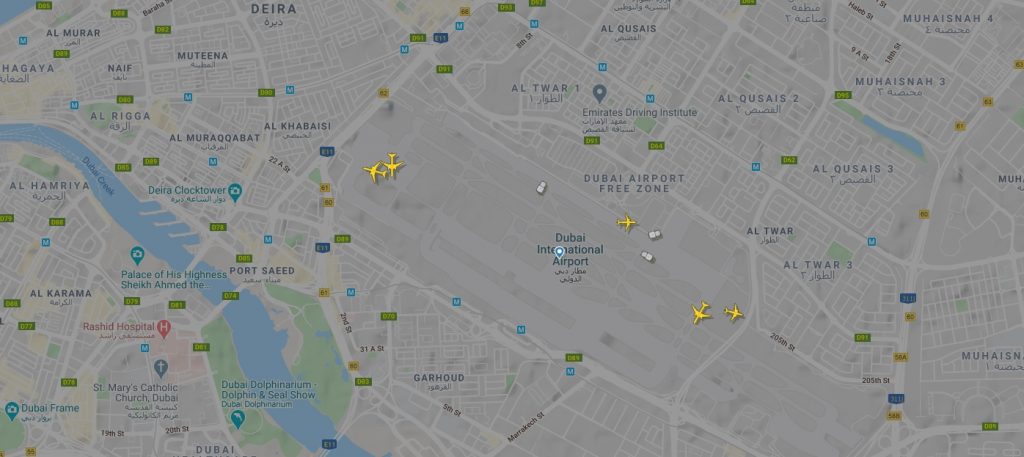
Well, you get the point. The sky has become much cleaner. So much so that there’s nowhere to ground airplanes. At the end of April 2020, air traffic in Europe dropped by 90%.
Which airlines currently operate the most flights?
On April 23, the Director General of the European Organization for the Safety of Air Navigation (aka Eurocontrol), Eamonn Brennan, posted interesting flight data in Twitter. Most interesting facts:
- Most flights are operated by DHL Express. Another 4 cargo carriers are in the Top 20 by the number of flights.
- Among the passenger airlines, the Norwegian airline Widerøe was the leader with 197 flights. It is followed by Turkish Airlines (149) and Lufthansa (111).
- In the Top 20, there was even a place for two helicopter carriers and the French Air Force.
Why does Widerøe fly more than anybody else in Europe?
The answer is simple.
Firstly, in Norway, domestic flights did not stop. Secondly, Widerøe, as a regional airline, is mainly engaged in domestic transportation. As a result, the global lockdown has no critical impact on a local airline. That’s the whole phenomenon.
As for the number of flights operated, Widerøe became the leader with 197 flights. Before the crisis, Ryanair occupied first place in the same period last year with approximately 2,500 flights. That’s the scope of the air traffic drop in Europe.
What news do airlines have?
Disturbing news continues to come one after another. For this reason, even this article had to be edited several times. And it will be more.
But at the beginning of March, it all seemed a bit different. There were expectations that all this wouldn’t last long. And during the summer season it will be possible to compensate spring losses due to an unexpected infection.
Wizz Air
One illustrative example is the comment dynamics of the Hungarian low-cost airline Wizz Air.
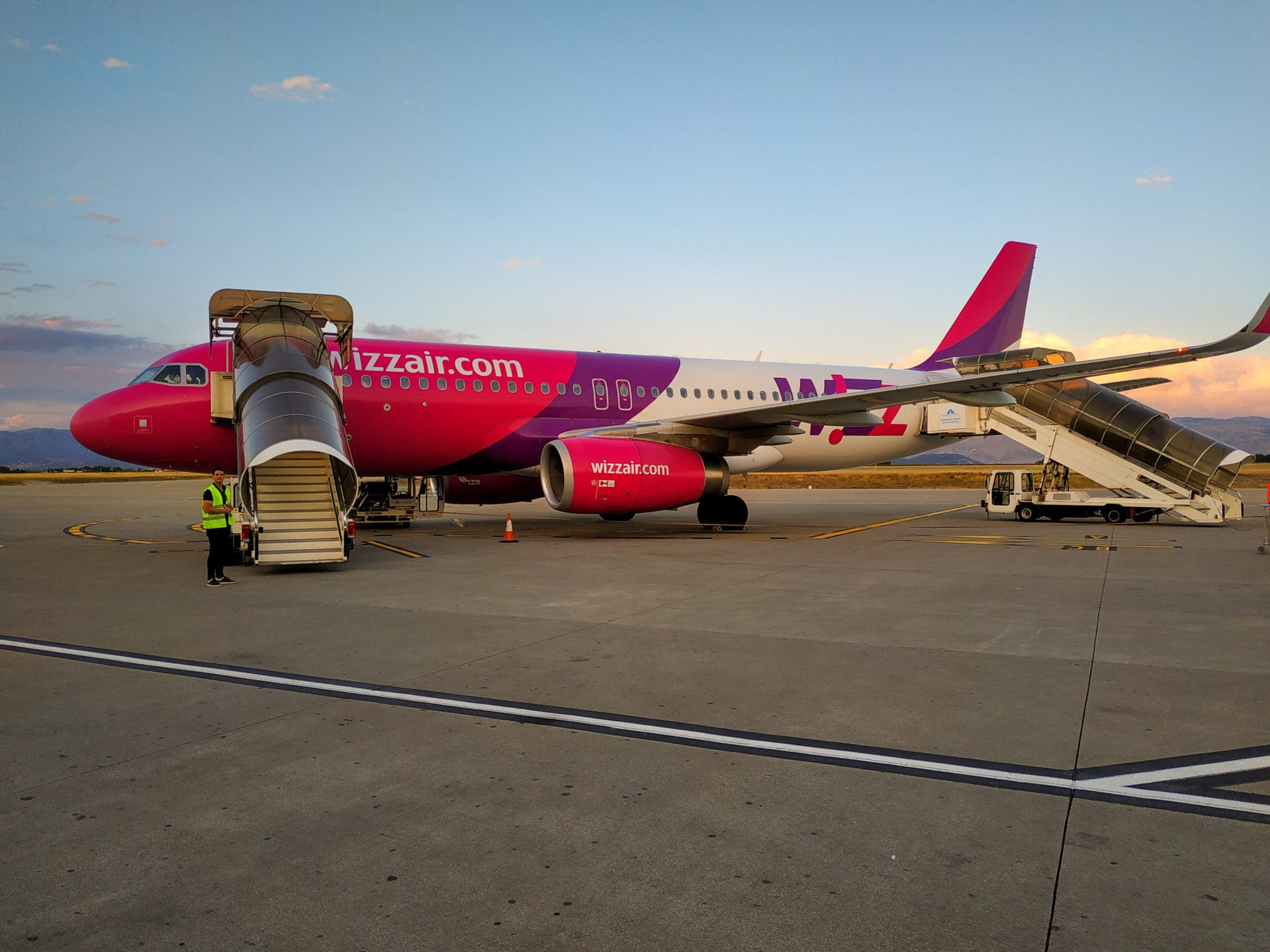
In mid-March 2020, when the scope of the passenger traffic reduction had already become apparent, the company commented on the situation optimistically. With a confidence that low-cost airlines are more resistant to market crises.
The company went into the crisis with a €1.5 billion and a 3-year safety margin. Wizz Air did not plan to cut staff and abandon the plans to get new aircraft. They planned to occupy niches that will be lost by weaker airlines, who were not ready for the crisis.
In early April, the tone remained optimistic. But the announced time that Wizz Air could stand without flights was estimated more modestly – 1.5 years. Although, in comparison with the problems of many other air carriers, this figure is more than impressive. Along the way, it was announced a reduction in staff salaries by 50% to reduce costs.
In mid-April, the low-cost airline announced its intention to fire 1,000 employees. It’s 19% of all the airline personnel. Among other measures to reduce costs, it was announced to send employees on vacation. And it’s not surprising, given the 3% load compared to the pre-crisis times. The announced safety margin is the same – 1.5 years without flights.
In late April, Wizz Air announced rough plans for the future. After removing the flight restrictions, they expect to load by approximately 30% of the target level. Over the next 2-3 months, this figure should increase to 75–80%. Within 5-6 months they plan to reach 100%.
The airline is still not going to refuse to buy the ordered planes. Over the next 20 months, Wizz Air plans to get 25 brand new Airbus A321neo.
Moreover, at the very end of April, the company announced the launch of the second base in Ukraine, at the Lviv airport on July 1, 2020. Together with the airbase, 7 new routes will be opened. From Lviv Wizz Air will fly to Billund (Denmark), Tallinn (Estonia), Lisbon (Portugal), Hamburg (Germany), Szczecin (Poland). And from Kharkiv – to Tallinn and Berlin.
Of course, new flights can be operated only after the removal of quarantine restrictions on flights in Ukraine and the countries in which the mentioned airports are located.
The company is confident that they will overcome the crisis in the status of one of the beneficiaries. Planning expansion. And not only due to filling the vacuum of passenger flights in Europe, formed due to the difficulties of the aviation market players.
In March, Wizz Air entered into a final agreement with its partner, Abu Dhabi Developmental Holding Company, to jointly create a new airline in Abu Dhabi. The new carrier plans to operate flights in the Middle East, Europe, Asia, and Africa.
They planned to start flying in autumn. Will see how it turns out in reality. I expect the launch of this project with special impatience. What will be the map of routes and prices for the Emirate’s Wizz Air? It is exciting.
Takeaways?
Firstly, Wizz Air appeared to be ready for a crisis. Although they also did not evaluate the effect of the pandemic in the initial stages accurately. But low-cost airline responds promptly and intelligently to changing conditions. And, yes, agree. The dismissed employees are unlikely to agree with me on this.
Secondly, we can see how much the number of flights has dropped even for the company that was engaged in returning the citizens home after border closures. Many did not have the opportunity to get even these flights.
What’s with the largest low-cost airline?
Not so good, like with everybody else. Ryanair is also convinced that the low-cost model is significantly more resistant to crises. The airline expected a slight revival of traffic at the end of summer. But later forecasts were revised.
Updated on May 20, 2020. On May 12, Ryanair announced plans to resume 40% of flights from July 1, 2020.
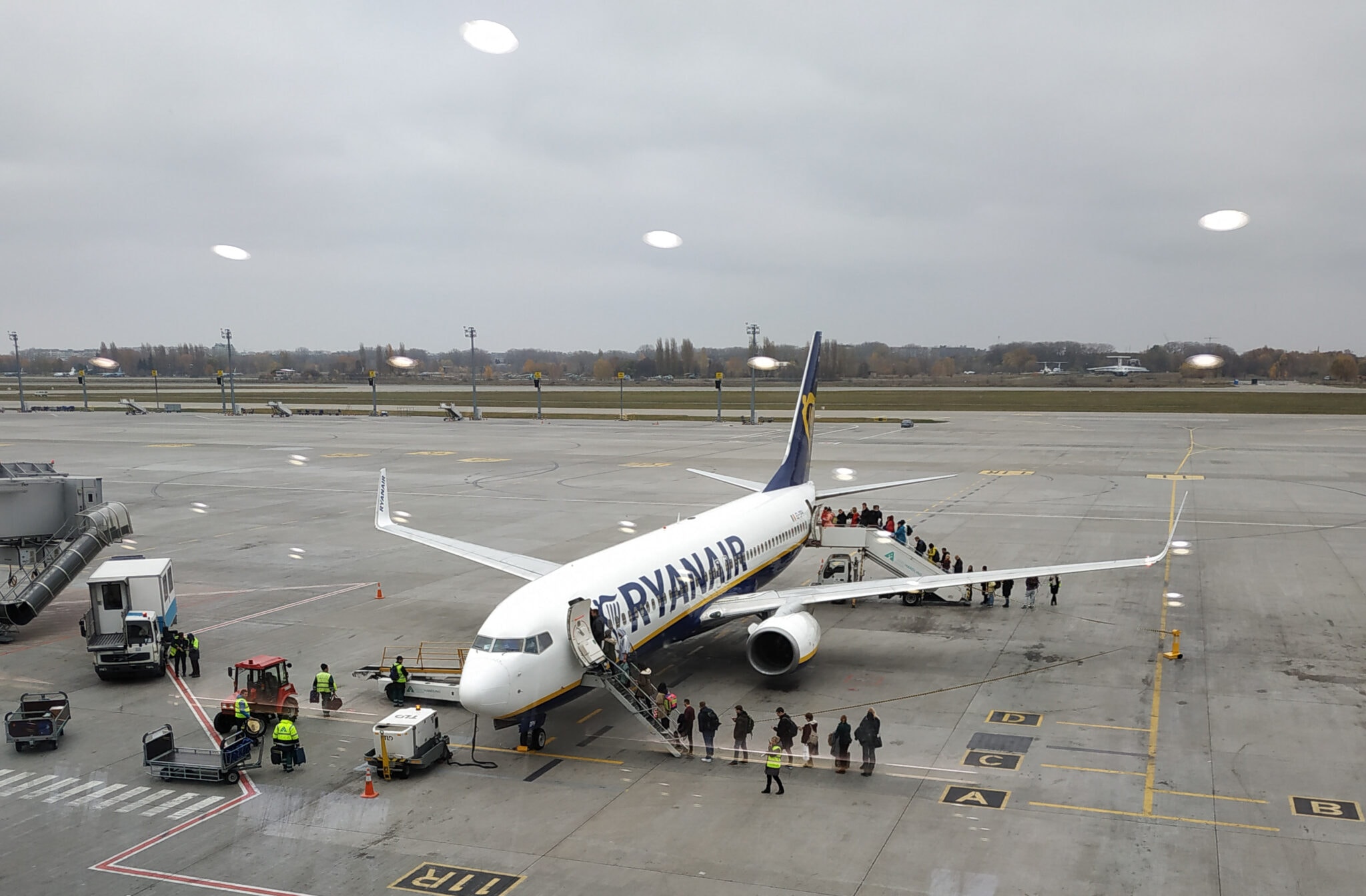
Irish low-coster believes that prices will remain low until 2021. And at first, they stated that it wasn’t so vital for them how much tickets would cost just after the restart. The main thing is to return the crews to the sky as soon as possible. Although later it became clear that the financial aspect is still matters.
Ryanair has not yet requested support from the Irish government. They rather delivered an ultimatum. The essence of the problem is the ongoing talk that, for health security reasons, the new flight conditions will include an empty middle seat. It will increase the distance between passengers and reduce the likelihood of infection.
Ryanair CEO Michael O’Leary said that on such conditions, their low-cost business model would be in tatters. Since low prices are achieved due to the maximum load of the cabin, it’s logical.
An empty middle seat would mean a 66% of cabin load, in the best case. So you will either have to incur losses or raise prices. Raising prices, in turn, will negatively affect the loading of the cabin. Vicious circle. And here everything is logical. The low-cost model works that way.
O’Leary was pretty straightforward in his remarks. Either the Irish government pays for an empty middle seat, or Ryanair doesn’t fly. Will there be an empty middle seat in the new rules, and what Ireland will choose – we’ll see. I hope soon.
Updated on May 1, 2020. Ryanair announced plans to fire 3,000 employees. It’s 15% of all airline personnel. This decision will mainly affect pilots and cabin crew. Also, Ryanair planned to close some airbases.
easyJet?
And here is the information from the third major European low-coster. British airline easyJet has stated that it has enough financial resources to survive 9 months without flights.
What about the rest of the low-cost airlines?
It differs from company to company. For example, just in the process of writing this article, the news came about the bankruptcy of two Norwegian subsidiaries in Sweden and Denmark. “Norwegian” here – the name of the low-coster.
This name may say nothing to someone. But it is a relatively big low-cost airline. From several European airports they fly to the USA at a very attractive price.
Not every low-cost airline is financially sustainable just because it sells cheap tickets. This model can work successfully while observing three main aspects:
- High traffic. I mean, really high.
- Maximally efficient organization and automation of all processes.
- Reliable financial risk management.
If at least one condition isn’t met, a low-cost airline will have a difficult time in our turbulent time.
I tend to agree with the statement of Ryanair and Wizz Air that they are more likely to be more resilient to the crisis.
Firstly, because of their model of work, that implies costs minimizing.
Secondly, large low-cost airlines are private companies. Unlike the so-called “national” air carriers, in case of serious problems, they shouldn’t rely on the state’s help. For this reason, a more significant safety margin is initially laid in the business model.
But crises like the current one were unlikely taken into account in the process of modeling.
Regular airlines
There are no reports about the significant bankruptcies of other carriers so far. It’s understandable. Not enough time has passed for the problems to become critical. But in a couple of months it may change significantly for some airlines. Especially considering that the winter season is subsidized and the summer one is donor. Companies receive their highest income in the summer. And in 2020, the summer season will be mostly lost.
Many airlines will have to rely only on state support or loans. And the second option for most of them is not an option. Governments will not support all carriers registered in the country. In most cases, one, the primary national air carrier, can expect to get help. Somewhere – two. Of course, neither Emirates Airlines nor Etihad Airways will go bankrupt in the UAE. The rest will have to rely on their own.
You also need to understand that in many countries there are no resources to support national carriers. And support is not expected. It would be great to have enough resources to overcome the pandemic. President of Ukraine Volodymyr Zelensky, for example, spoke of launching a national airline, rather than supporting existing private ones.
In any case, now we can only state the declaration of readiness to support national carriers in developed and rich countries. The scope of this support will be known later. And it will depend on how long passenger planes will remain grounded. And on how much they will be able to get from budgets that are pretty battered by the coronavirus.
And we have first requests for state support. Let me give you a couple of examples.
Virgin
First, a short video from a glorious past. The year 2013. AirAsia flight from Australian Perth to Malaysian Kuala Lumpur.
Sir Richard Branson, a billionaire. The happy owner of private islands, Virgin Airlines, and several hundred different companies. He once lost a wager to Tony Fernandes, the founder of the AirAsia low-cost airline. Under the wager’s terms, the loser had to work as a stewardess on an opponent’s airline flight.
In April 2020, Branson was no longer joking. He stated the need for government support in an open letter to company employees. And he “asked” for help from two states at once – the UK and Australia.
Lufthansa
On April 7, the main German airline announced several essential decisions connected with the crisis caused by the coronavirus pandemic. Among them:
- stop the activities of the subsidiary airline – the low-coster Germanwings.
- terminate all leasing agreements.
Lufthansa believes that months will pass before travel restrictions are lifted worldwide. And it will take years to achieve the pre-crisis level of demand for passenger flights.
At the end of April, the airline announced losses for the first quarter of 2020. It is €1.2 billion. For some, such an amount could already be an adjudication. But it is Lufthansa. Therefore, with the amount of current liquidity contained in the report, €4.4 billion, there is no reason to panic. At the same time, the company itself recognizes that in the coming months liquidity will inevitably decline. Significantly.
To maintain financial stability, the company is negotiating with the governments of 4 countries at once – Germany, Austria, Switzerland, and Belgium.
“Why is it so immodest?” – you may think. Everything is simple. Lufthansa is not just a regular airline. It is a concern that includes several well-known brands, like Austrian Airlines, Swiss International Air Lines, and Brussels Airlines. These carriers are national in their respective countries. And local governments should be extremely concerned about their fate along with Lufthansa.
Updated on May 5, 2020. In early March, information appeared that the German government, using various financial instruments, plans to support Lufthansa for a total of €10 billion. Including the purchase of a 25.1% stake in the airline.
Air France-KLM
It is expected that both partners in the holding will receive government support. On April 24, 2020, French Finance Minister Bruno Le Maire announced the government’s intention to provide financial help to Air France for €7 billion. The Dutch government, in turn, expressed its readiness to finance KLM for €4 billion.
Updated on May 22, 2020. On May 15, Air Canada announced its intention to cut 50-60% of its workforce. It’s approximately 20000 employees.
In the nearest future, we will definitely see many requests for government support in one form or another. Or reports from various governments that such support will be provided. I’ll try to keep in touch.
This information will be useful when flights start resuming. It will help to determine the airline’s financial stability and, accordingly, the risks of being stuck somewhere due to an unexpected insolvency crisis.
How have air travel conditions already changed?
For better understanding, let’s learn an example not even with a passenger, but with a cargo plane. They don’t transport 200 people who are potential carriers of the virus, but only around 10. The danger is 20 times less.
And here is how they are doing on an example of the largest cargo plane in the world – An-225 “Mriya”. Unlike in “peaceful” times, now it is maximally loaded with flights. Mostly it’s transporting the goods and medicines for a battle with coronavirus.
Despite the vital (in the literal sense of the word) need for delivered goods, the crew has hard times. Not every airport accepts them even for refueling. Those who accept, in most cases, don’t allow to leave the plane. Loaded up, unloaded, and fly away. Sleep, wash somewhere in your cabin. Permission to go to spend the night at a hotel is already a great holiday.
These are the realities now, even for cargo carriers. It makes it clear in what conditions passenger flights will come to life.
How will it be after resuming flights?
Number of flights
All flights on all previous routes by all airlines will not resume in one moment. The restart will be gradual. Domestic traffic, predictably, will start to recover first.
It is impossible to predict how battered will different airlines come to the restart. Definitely, a series of bankruptcies awaits us. Purchasing and re-purchasing the aircraft. Lease out and re-leasing. Who and with what fleet will enter the phase of resuming flights, will be known 5 minutes before the start.
Restrictions
Not all countries will remove quarantine simultaneously and equally. It will be possible for citizens to fly out of some countries, but foreigners will not be allowed to fly in. Some countries will remain entirely closed for passenger flights for some time. At the first stage, the flight map will be torn.
The global redrawing of schedules is coming
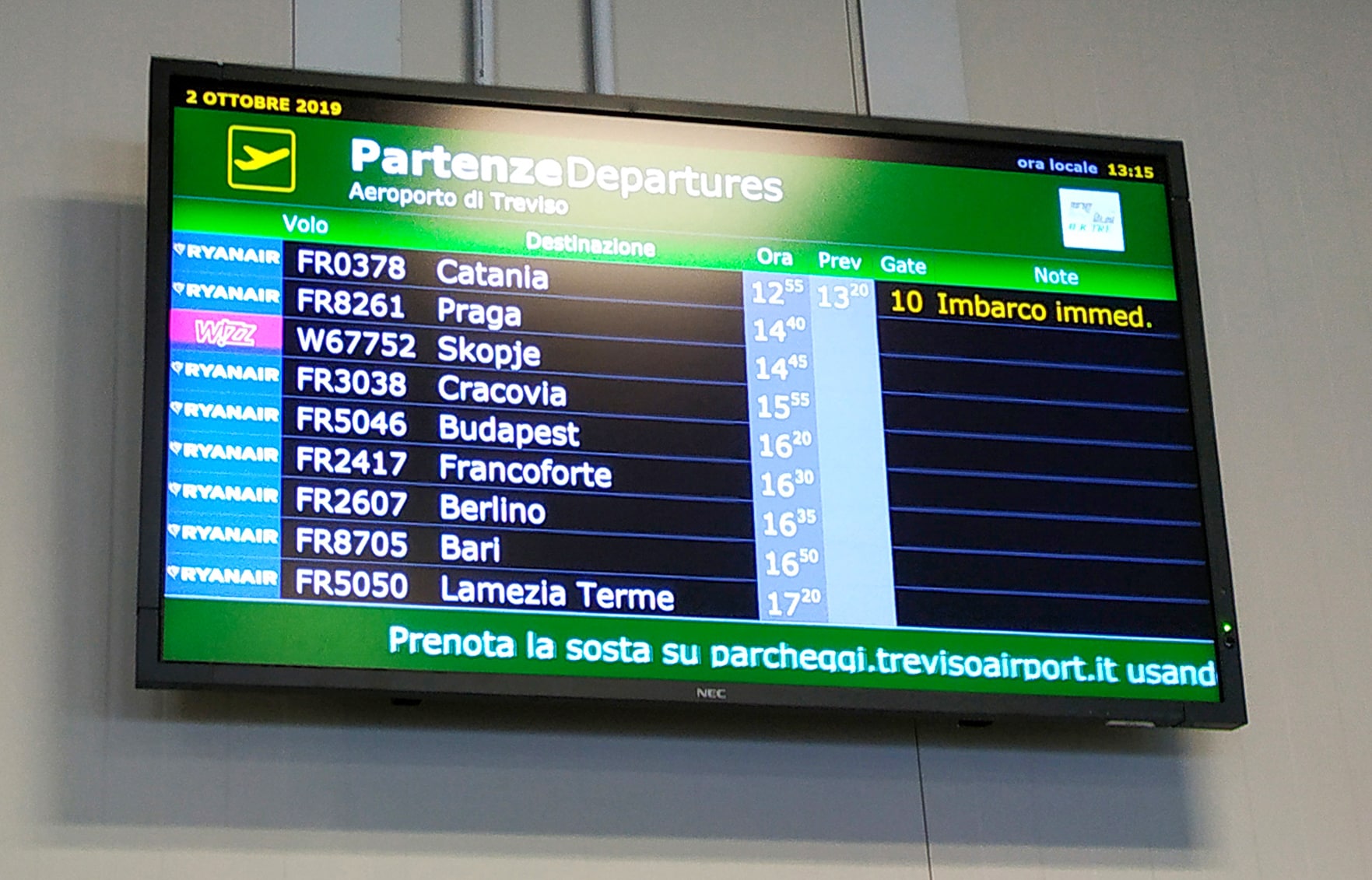
Some airlines will be forced to leave “their” routes. Others will want to replace them. Issuing permits for routes and airports, countries will be forced to balance. Between protecting the interests of the national carrier and the obligation to serve the needs of passengers from among their own citizens. It will mostly affect intercontinental flights.
I expect “eating” routes of small airlines in continental and regional passenger flights by larger ones, with powerful state support behind you.
First flights will be for chosen ones
It’s just my guess. I do not rule out the scenario when regular flights at the initial stage will be to restore business processes. To return home people who couldn’t return earlier due to the global lockdown. For family reunion. For medical reasons, if it is impossible to get the required medical help at home. Etc.
Routes
In some countries airports can be closed, in some – the airspace. Some routes will change, become longer. As a result, flights will become “more expensive by distance.” But it won’t necessarily affect the ticket prices.
Pricing
As mentioned above, the cost of flights on the first stage will be higher than usual. Does it mean that tickets will automatically become more expensive? Not necessary. There is an unshakable market law – demand generates supply. Even corona won’t cancel it.
We also add that high competition has downward pressure on prices. Low competition lifts them. And for the first opening routes, a severe fight is expected. Even with a small number of passengers and potential losses.
Why is that? It is much more profitable for airlines to fly, even with small temporary losses than keeping planes grounded. Because the last option also costs a lot of money, with zero income.
War for the passenger
At the initial stage, the price will significantly depend on the specific route. How many companies want and will be ready to serve it.
Airlines with strong government support will be able to maintain low prices on tasty routes for some time to stake out profitable routes. Having insidious plans to make money on them afterward, consistently. Bulling prices from the start, with limited demand and high competition, is not a good strategy.
Kerosene for a penny
Collapsed oil prices speak in favor of cheap tickets. It means that fuel costs will remain low for some time.
How long can this go on? At least, while oil production exceeds its consumption, as it is happening now. When consumption again exceeds production, prices will gradually rise.
They’ll be raising slowly. Because it’s already such an overabundance of extracted oil that it simply has nowhere to store. It got to the point that tankers intended for its transportation are used as storage facilities. All happy owners of black slurry will try to sell it as fast as possible. And oil demand will resume slowly. These conditions are not the best for oil price raising.
For some destinations prices will be ridiculously high
Many routes in the world are less attractive to air carriers, for one reason or another. Few airlines are willing to work on them. As a result, regular flights to some locations can be called regular only formally. Such routes often are subsidized as socially significant. If not, tickets become extremely expensive.
So, with a temporary reduction of airline facilities, some of the subsidized routes will inevitably migrate to the “ridiculously expensive” category. At least until the stabilization of the situation on the aviation market.
If you have to fly with an empty “middle” seat, keeping prices low will also be more difficult.
Security and health controls
For a security purpose, they will check not only what you carry with you, but also what is inside you. It seems like since now an attempt to bring a coronavirus will be equated to the effort to bring the Samsung Galaxy Note 7 onboard. Both of these will be an excellent opportunity to stay at the airport. With a small difference. You can leave your smartphone to friends or relatives at the airport. Send it home by delivery service. Or even throw it into the carbage. With the virus, most of these options will be unavailable.
How will they check for coronavirus? We’ll understand it more clearly closer to the beginning of the massive return of planes to the sky. At the moment, we can only see the outlines of how the screening for a disease will be carried out. One solution belongs to Etihad Airways from the UAE. They planned to test it at the end of April and May 2020 at the Abu Dhabi airport.
The essence of the new system is the surface screening of a passenger. Special devices will be installed at all passenger contact points with the airport systems and personnel. Such as security controls, check-in desks, self-service kiosks, baggage claim desks, etc.
Automatic devices will check such passenger health indicators as temperature, heart rate, respiratory rate. It’s an early detection, but not a medical diagnosis tool. If deviations are detected, the system will signal, and the passenger can be forwarded for an additional check by qualified airport personnel.
Also, the system provides the ability to control the process of self-registration using voice commands. It helps to minimize the risk of transmission of the virus through touch. In implementing this “voice” solution, the system developer, Elenium, used Amazon Web Services.
The described system is not an urgent adaptation to coronavirus. It was introduced previously in the regular mode. But with a slightly different purpose – to improve the process of passenger self-service. The impending pandemic was just a reason to adopt the system for the new conditions.
PCR-test for COVID-19 directly at the airport
Updated on May 5, 2020
We can roughly understand the new requirements immediately after a full restart of the aviation market based on today’s realities at Vienna Airport.
Starting on May 4, 2020, both arriving and departing passengers can optionally undergo a PCR test for coronavirus at the Austrian capital airport. The result will be ready within 3 hours. This testing costs €190.
Based on the test results, a certificate is issued. How useful can it be? A negative test result relieves arriving passengers from the obligation to undergo a 14-day quarantine.
For departing passengers this certificate may come in handy at the destination airport. Having this certificate, you can prove that you are “clean.” It will help to avoid a lot of difficulties with entry.
I believe that on restart this procedure can become a basic one. At least for airports in the European Union. The price, of course, does not please. But it is still better than closed borders.
Innovations on board
It looks in the nearest future we will no longer recognize aircraft cabins.
Increased space between passengers
What Ryanair thinks about the idea with an empty middle seat, I’ve already written above. They are categorically against it.
But the British low-coster easyJet is ok with this solution if it allows unlocking air travel. And it seems to be because they are among the co-authors of this idea, together with the European Aviation Safety Agency (EASA). So far, the “empty middle ground” is only at the stage of discussion.
Another discussed proposal is the seating of passengers in the checkerboard order.
Back to front
There is a more exotic version of the seating – the middle chair turned in the opposite direction. And not empty, but with the passenger. In my opinion, this option seems pretty pointless. It sounds pretty pointless because one passenger will face other passengers sitting in the next row, albeit at an angle. And the safeness of this solution in case of an emergency landing is under question.
Protective plastic screens
The idea is to surround the head of the passenger with screens. So he or she couldn’t spit on a neighbor. But at the same time could freely eat, use the media screen located in front of the passenger. Basically, do all the usual manipulations on board, with minimal risk of infecting your neighbor.
However, such a design is unlikely to be introduced by the restart of flights. Plastic in this form in the cabin is a potentially dangerous thing. Screens will first have to pass safety compliance tests.
As you can see, an empty middle seat is not the most intricate idea that can become a reality in a few months.
Business-class with a shower won’t be a luxury anymore
No, I’m not trying to say that now they will be available to economy passengers for free. I mean that they will become beneficial for crew members who will have to stay in the cabin until the return flight at some airports. They will need to rest somewhere, especially on long routes. Undergo sanitizing procedures.
Business-class sections for these purposes are ideally suited. Those who have them are lucky.
Is there any good news, or trash only so far?
I see the positive, at least, in the fact that they are looking for solutions right now. Interested market participants do not expect that the pandemic problem will just resolve itself soon. They are ready to act now to be prepared as soon as possible to resume passenger flights in the new realities.
Of course, the considered list of potential innovations is a drop in the ocean from what will be finally introduced. I feel it with my coccyx that this summer will bring a lot of innovations.
Updated on May 5, 2020.
Masks and screening – yes. Empty middle seat – no.
The International Air Transport Association (IATA) has unveiled its vision of the necessary protection measures against the spread of coronavirus among passengers and crew.
The list of innovations proposed by IATA is as follows:
- Mandatory face-coverings for passengers and masks for the crew;
- Temperature screening of passengers, airport workers and travelers;
- Boarding and deplaning processes that reduce contact with other passengers or crew;
- Limiting movement within the cabin during flight;
- More frequent and deeper cabin cleaning;
- Simplified catering procedures that lower crew movement and interaction with passengers.
It is mentioned that the ventilation and air filtration system in modern aircraft significantly reduces the risk of the infection spreading on board.
Middle chair. IATA recommends not to infringe on it. Firstly, because this solution doesn’t significantly reduce the risks of spreading the infection. At the same time, it carries high risks for the survival of the aviation industry.
Due to the cabin load only by 2/3, airlines will have to raise airfares. Higher prices, in turn, will hit the load rate even more. Because of it, again, they’ll have to raise prices. And so on, until the logical result – bankruptcy. So IATA is in solidarity with Ryanair. Do not touch the middle seat.
So when we will fly?
When exactly regular passenger flights will resume, and how they will be carried out, nobody can say with 100% accuracy right now. Even until July a lot can change dramatically.
Nevertheless, some forecasts can be made quite reasonably. And making them is important. Are you a tourist or a businessman. Or a businessman engaged in tourism. Understanding the situation will help you save time, finances, and some nerves.
Who will fly first? And when?
I initially bet on Etihad Airways. They were already at a low start. Waited for the go-ahead from the UAE authorities. It was planned to resume flights on a reduced schedule from May 16, 2020.
They planned to restart based on the Abu Dhabi airport, where at the end of April they were going to begin testing a new system for early detection of diseases.
Updated on May 5, 2020. Etihad Airways has postponed the resumption of regular passenger flights until at least June 16, 2020. In case of an adverse epidemiological situation, this date may also be reviewed.
Updated on May 5, 2020. More agile guys were found.
On May 1, Wizz Air flew from Vienna to Dortmund and Lisbon. By other airlines you can also fly from Vienna to Doha, Dusseldorf, Frankfurt, Hamburg, Lisbon, Minsk and Sofia.
On May 4, 2020, the Dutch airline KLM resumed flights on the route Amsterdam – Prague. Two more airlines flew to the Czech capital. Eurowings, the German subsidiary of Lufthansa – from Düsseldorf. And the Belarusian “Belavia” from Minsk. That’s the news from the Czech Republic, who revealed first in Europe.
Meanwhile, Lufthansa is preparing to resume regular flights on the Frankfurt – Vilnius route on May 13. The Lithuanian government allowed the German airline to operate the flight three times a week.
Where in Europe you can have a rest in the pandemic summer of 2020?
Montenegro
This country has taken the most effective measures in the battle with the coronavirus. Montenegro was the last European country in which the first infected was detected. And at the same time, one of the first, where the number of active cases started to reduce.
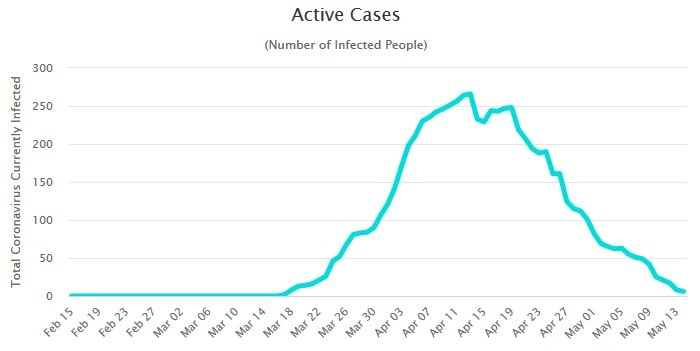
Initially, the opening of Montenegro’s borders in July seemed to be a practically settled matter. Maybe even in June. There was not much sense to do it earlier since the rest of the European countries were not as successful with corona.

It remains to settle the procedures for the functioning of tourism infrastructure in the new realities. What’s important, Montenegro is not a member of the European Union, and can afford to make independent decisions. It makes it possible to take more flexible measures and promptly correct them.
One of the unresolved issues is air traffic. Who and from which countries will be the first to start flights to Montenegro is not clear yet. One of the main airlines operating in Montenegro before the crisis was Wizz Air, which flew from Italy, Germany, and Hungary.
Updated on May 27, 2020. The last patient of 324 registered in Montenegro recovered on May 24. It means that Montenegro was “infected” last in Europe, and “recovered” first (except for the Faroe Islands, which are actually a part of Denmark). At a minimum, it can be stated that the first wave of the coronavirus pandemic in the country has passed.
And it is already known when it will be possible to enter Montenegro, and from which countries. Montenegro will open its borders in the first week of June. It will be possible to come from countries where the number of infected (active cases) is less than 25 per 100,000 of the population. What are these countries? “Croatia, Slovenia, Austria, Germany, Poland, Czech Republic, Hungary, Albania, Greece, and some other countries.”
Updated on May 29, 2020. Montenegro announced the date for opening borders and countries that meet the criteria. From June 1, it will be possible to enter Montenegro from Croatia, Bosnia and Herzegovina, Northern Macedonia, Slovenia, Hungary, Bulgaria, Germany, Switzerland, Austria, Luxembourg, Albania, Kosovo, Greece, the Czech Republic, Slovakia, Norway, Finland, Denmark, Ireland, Iceland, Estonia, Lithuania, Latvia, Monaco, Azerbaijan, Israel.
Updated on June 1, 2020. The list of countries meeting the entry criteria has been significantly expanded. Now there are 120 of them. It’s also specified that the entry of a foreigner into Montenegro will be allowed subject to two conditions. He must be a citizen of the “permitted” country and enter from the territory of the “permitted” country (important, for example, in case of connecting flights in third countries).
A complete list of countries from which entry into Montenegro is allowed from June 1 can be found here.
Cyprus
I think Montenegro will not be the only country that will manage to get some tourists in the tricky summer of 2020. Currently, Cyprus seems to be one of its real competitors, which also plans to start hosting tourists in July.
The country was not hugely affected by the pandemic. And Cyprus, being a member of the European Union, is not a Schengen agreement participant. Therefore, it can make fairly independent decisions on opening borders.
Updated on May 5, 2020. Health Minister of Cyprus Konstantinos Ioannou announced the resumption of flights from June 9, 2020. It should happen at the third stage of exit from the quarantine. On the same day, it is planned to resume servicing cruise ships. Cafes and restaurants will be allowed to serve visitors both outside and inside.
The first phase of quitting quarantine in Cyprus began on May 4. And the last, fourth, will start on July 14. At this stage it is planned to open theaters, cinemas, and casinos. Festivals and concerts also will be allowed.
Turkey
Special tourist solutions are also being prepared by Turkey, where the situation remains difficult, although the peak seems to have been passed. A significant advantage of Turkey is Turkish Airlines. With the help of this colossus’s facilities, it will be possible to quickly launch navigation with “clean” countries or regions where a lot of potential tourists are at a low start.
Stay tuned
I continue to monitor the situation. Will keep you informed.
But you may also periodically have a glance at the current state of things. As the triangles begin to blush, then the flights will resume soon.